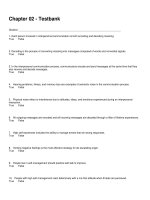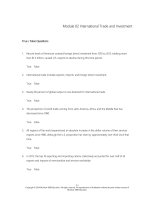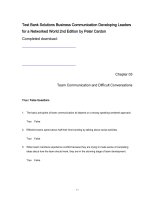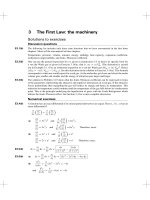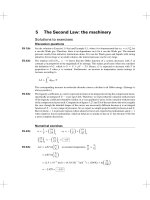Instructor’s manual to accompany BUSINESS COMMUNICATION developing leaders for a networked world 2nd edition
Bạn đang xem bản rút gọn của tài liệu. Xem và tải ngay bản đầy đủ của tài liệu tại đây (2.66 MB, 19 trang )
Instructor’s Manual to Accompany
BUSINESS COMMUNICATION
Test Bank Business Communication Developing Leaders for a
Networked World 2nd Edition Peter Cardon. Download:
/>
Chapter 3:
Team Communication and Difficult
Conversations
IM 3-1
Chapter 3 Summary and PowerPoint Notes
SLIDE 3-1
SLIDE 3-2
This chapter covers the following topics: principles
of team communication; approaches to effective
meetings; effective virtual teams; group writing
strategies; and handling difficult conversations.
SLIDE 3-3
LO3.1 Explain the principles of team
communication in high-performing teams.
LO3.2 Describe and demonstrate approaches to
planning, running, and following up on meetings.
LO3.3 Explain the principles of effective virtual
team communication.
LO3.4 Describe strategies for effective group
writing.
LO3.5 Explain basic principles for handling difficult
conversations.
IM 3-2
SLIDE 3-4
Teams can take many forms. Some teams are
formally and permanently organized and titled
(such as the marketing team). Other teams are
temporarily formed for completing a project or an
activity (i.e., project team, committee). The most
common functions of teams are handling special
projects, completing the work of particular
departments, developing internal systems
innovations, creating customer-service
innovations, developing product innovations,
engaging in employee development, and reducing
time to market for products and services.
SLIDE 3-5
In a recent survey, business professionals cited
ineffective communication (66 percent) as the
biggest barrier to team effectiveness. Other major
barriers included lack of effective chartering and
goal setting (56 percent), lack of clarity and
understanding of roles (47 percent), low morale
(44 percent), low productivity (42 percent), and
lack of trust (36 percent). All of these factors
relate to communication competencies.
SLIDE 3-6
Similarly, when ranking the most frustrating
aspects of being part of a team, business
professionals cite the following: ineffective use of
meeting time (54 percent), ineffective
communication among team members (50
percent), lack of accountability (47 percent),
individuals who don’t complete assignments (44
percent), and lack of preparation in meetings (41
percent). All of these factors in turn relate to
communication competencies.
IM 3-3
SLIDE 3-7
Your teams will perform far better if they follow
the basic principles of team communication, all of
which depend on a strong listening-centered
approach. Work in teams is among the most
researched aspects of work performance, and
hundreds of studies have supported each of the
following principles:
Teams should focus first and foremost on
performance.
Teams go through four natural stages to
reach high performance.
Effective teams build a work culture around
values, norms, and goals.
Effective teams meet often.
SLIDE 3-8
Some additional principles are:
Effective teams embrace differing viewpoints
and conflict.
Effective teams find out the communication
styles and preferences of one another.
Effective teams provide a lot of positive
feedback and evaluate their performance
often.
Effective teams feel a common sense of
purpose.
SLIDE 3-9
Nearly all high-performing teams go through four
stages before they maximize their performance. In
best-case scenarios, work teams take roughly six
to seven months to reach this level (see Figure
3.1). Typically, leaders become less directive and
more consultative as the team progresses through
the stages: forming, storming, norming, and
performing.
IM 3-4
SLIDE 3-10
In the forming stage (months 1 and 2), team
members focus on gaining acceptance and
avoiding conflict. In some ways, this stage is a
honeymoon period in which team members get to
know one another.
In the storming stage (months 2 and 3), team
members open up with their competing ideas
about how the team should approach work. This
stage is typically the least productive, since team
members are attempting to make sense of
uncertain roles, goals, and accountabilities.
SLIDE 3-11
In the norming stage (months 4 and 5), the team
arrives at a work plan, including the roles, goals,
and accountabilities.
In the performing stage (months 6 and 7), teams
operate efficiently toward accomplishing their
goals. They have evolved to a level where they can
transform disagreement and conflict into
consensus for future action.
SLIDE 3-12
Organizations and teams constantly attempt to
foster unity and high performance. Team culture
refers to a set of shared perceptions and
commitment to collective values, norms, roles,
responsibilities, and goals. Typically, teams rapidly
develop such shared perceptions and
commitment during the norming stage. Only at
the performing stage do these shared perceptions
and commitments lead to high productivity.
IM 3-5
SLIDE 3-13
One way that high-performing teams ensure they
develop and live up to shared values, norms, and
goals is to create a team charter. The team charter
provides direction to the team in how it functions
to meet shared objectives. Common elements of
team charters include purpose or mission
statements, values, goals, team member roles
(including leadership), tasks, ground rules,
communication protocol, meeting protocol,
decision-making rules, conflict resolution, and
feedback mechanisms. In Figure 3.2 you can see
an abbreviated team charter created by the
Prestigio marketing team. It contains many
features common to team charters.
SLIDE 3-14
One way teams can welcome new ideas is to
embrace diversity. Increasingly, research shows
that diversity brings better business returns.
Diversity comes in two forms: inherent and
acquired. Inherent diversity involves traits such as
age, gender, ethnicity, and sexual orientation.
Acquired diversity involves traits you acquire
through experience, such as customer service
experience, retail experience, or engineering
experience. Having both types of diversity is called
2-D diversity.
SLIDE 3-15
The following behaviors help drive acquired
diversity: (1) making sure everyone is heard; (2)
making it safe to let team members express novel
ideas; (3) giving team members decision-making
authority; (4) sharing credit; (5) giving useful
feedback; and (6) putting feedback into action. In
short, these behaviors drive an innovative, “speakup culture.”
IM 3-6
SLIDE 3-16
Two principles that team members use to
embrace and respond to differing viewpoints are
disassociation and association. Disassociation is a
process by which professionals accept critique of
their ideas without taking it personally and
becoming defensive. On the other hand,
association is the psychological bonding that
occurs between people and their ideas. Since the
purpose of most meetings and team
communication is to increase agreement about
roles, goals, and accountabilities and to increase
the group’s sense of purpose, team members
should seek association by the end of a meeting or
team communication. Generally, high-performing
teams go through repeated cycles of
disassociation and association. That is, they
suspend attachment to ideas in the initial
discussion phase and then attach themselves to
ideas as they commit to mutually developed goals
and related action items (see Figure 3.3).
SLIDE 3-17
Running effective meetings starts with planning.
Planning for meetings requires strategy,
scheduling, and coordination. At a minimum, you
should answer the following questions in your
preparations:
What is the purpose of the meeting? What
outcomes do I expect?
Who should attend?
When should the meeting be scheduled?
What roles and responsibilities should people
at the meeting have?
What will be the agenda?
IM 3-7
SLIDE 3-18
Some additional questions to ask are:
What materials should I distribute prior to the
meeting?
When and how should I invite others?
What logistical issues do I need to take care
of (reserving rooms, getting equipment,
printing materials)?
SLIDE 3-19
Think about how scheduling will impact
productivity. Generally, you should avoid
meetings, especially brainstorming meetings,
during the least productive times of the day
(usually the afternoon). Typically, most employees
are at their best performance in the morning (see
Figure 3.5).
SLIDE 3-20
As you plan, consider the type of meeting you
want. Meetings can be broadly categorized as
coordination meetings or problem-solving
meetings. Coordination meetings primarily focus
on discussing roles, goals, and accountabilities.
Problem-solving meetings typically involve
brainstorming about how to address and solve a
particular work problem. In actuality, nearly all
meetings involve both coordination and problem
solving. However, coordination meetings typically
include many agenda items with a reasonable
expectation of accomplishing each item in the
allocated time. Problem-solving meetings, by
contrast, involve more fluid issues that are less
easily classified as discrete agenda items and that
are less easily given time allotments.
IM 3-8
SLIDE 3-21
Agendas provide structure for meetings. For most
meetings, preparing and distributing an agenda
ahead of time allows each meeting participant to
form expectations and prepare. Most agendas
should include items to be covered, time frames,
goals and/or expected outcomes, roles, and
materials needed. You can foster more effective
meetings by getting others involved in the
agenda-creation process. You can also consider
assigning roles.
SLIDE 3-22
As you develop the agenda, pay attention to the
ordering of items so that it flows much as you
would expect other written communications to
flow from point to point. Also, consider placing
those agenda items of most importance near the
beginning. This way, if items take longer than
expected and you are forced to shelve some
items, you have addressed the highest-priority
items. See Figure 3.6 for an agenda for the
Prestigio marketing team.
SLIDE 3-23
If you’ve planned and prepared well for the
meeting, you are in a great position to carry out
your meeting objectives. Ideally, you’ve provided
clear expectations for meeting participants—what
they should have done before the meeting and
what they can expect in terms of content and
length of the meeting. Once the meeting arrives,
you have several options for achieving productive
outcomes:
Create tradition, culture, and variety.
Set expectations and follow the agenda.
Encourage participation and expression of
ideas.
Build consensus and a plan of action.
Close the meeting.
Deal with difficult people.
IM 3-9
SLIDE 3-24
One priority should be to end the meeting on
time. Before ending the meeting, summarize what
you have accomplished. In just a few minutes, you
can recap action items that the team has agreed
on. After a meeting ends (even for those you do
not lead), you should mentally evaluate your
performance. Consider these questions:
How much information, analysis, and
interpretation did I provide?
Did I communicate my ideas even if they
conflicted with someone else’s?
Did I participate in the implementation of the
timeline? Did I meet deadlines?
Did I facilitate the decision-making process?
Or did I just go with the flow?
SLIDE 3-25
Follow up by distributing the minutes of the
meeting (as a memo, in an email, in a meetings
folder on the corporate intranet, or as part of a
team blog or wiki). Minutes of the meeting should
include the date and time, team members
present, decisions, key discussion points, open
issues, and action items and related deadlines.
You can also include the names of people who
were invited but were absent and the names of
people with assigned roles (such as the notetaker).
IM 3-10
SLIDE 3-26
The minutes serve as a record of what your team
accomplished in the meeting. Figure 3.7 provides
an example of meeting minutes.
SLIDE 3-27
Organizations increasingly rely on virtual teams to
complete projects, initiatives, and a variety of
other tasks. These virtual teams generally consist
of team members located at various offices
(including home offices) and rely almost entirely
on virtual technologies to work with one another.
One recent survey showed that about 80 percent
of professionals in multinational companies report
working on a team that is located in different
locations. In fact, 64 percent of these
professionals work with team members located in
other countries.
SLIDE 3-28
In addition to the principles for working effectively
in traditional teams, consider the following tips
when working in virtual teams:
Focus on building trust at each stage of your
virtual team.
Meet in person if possible.
Get to know one another.
Use collaborative technologies.
Choose an active team leader.
IM 3-11
SLIDE 3-29
Compared to traditional teams, virtual teams
typically find it more challenging to maintain trust
over the duration of their work together.
Typically, you can take actions across the entire
life cycle of a virtual team that bolster your
credibility and help establish trust within your
virtual team with a focus on competence, caring,
and character. In Table 3.1 you can see various
strategies for displaying competence, caring, and
character at each stage of virtual teamwork to
build and maintain trust within the team.
SLIDE 3-30
Consider the following tips to make your virtual
meetings more productive:
Start the meeting with social chat.
Start with a contentious question.
Ask “what do you think about” questions.
Make sure each team member is involved.
Articulate views precisely.
Take minutes in real time.
Focus on your teammates and avoid
multitasking.
Use video when possible.
IM 3-12
SLIDE 3-31
Creating a strong, precise, and coherent
document with many writers is challenging. As
you write with teams or other groups, consider
applying the following tips:
Start right away.
Work together at the planning stage.
Make sure your roles and contributions are
fair.
Stay flexible and open.
Meet in real time consistently and ensure the
writing reflects the views of the group.
Discuss how you will edit the document
together.
Consider a single group member to polish the
final version and ensure a consistent voice.
SLIDE 3-32
Business professionals routinely—often on a daily
basis—encounter difficult conversations,
especially when working in teams and
collaborating with others. Difficult conversations
are approached with apprehension, nervousness,
anxiety, and even fear. Difficult conversations
often center on disagreements, conflict, and bad
news. Many people prefer to avoid difficult
conversations because they want to avoid hurting
the feelings of others, want to avoid conflict, or
for other reasons.
IM 3-13
SLIDE 3-33
Most people back away from uncomfortable or
unpleasant conversations. This is particularly the
case when we feel we have a lot to gain but risk
heavy losses if it doesn’t go right. For these
reasons, difficult conversations are often
emotionally challenging. Successful people in the
workplace do not evade difficult conversations.
Those who regularly tackle them with skill and tact
improve work performance for themselves and
others. Some tried-and-true principles for
handling difficult conversations in the workplace
are:
• Embrace difficult conversations.
• Assume the best in others.
• Adopt a learning stance.
• Stay calm/overcome noise.
• Find common ground.
• Disagree diplomatically.
• Avoid exaggeration and either/or approaches.
SLIDE 3-34
One way to embrace difficult conversations is to
view conflict as an opportunity. That is, the
exchange of perspectives and competing ideas
reflects open and honest communication. If there
is no conflict, employees are likely not voicing
their true perspectives. Generally, colleagues tend
to respect one another more when they know
they can safely disagree.
The components of difficult conversations are:
1. Start well/declare your intent.
2. Listen to their story.
3. Tell your story.
4. Create a shared story.
IM 3-14
SLIDE 3-35
After studying this chapter, you should
understand the following topics: principles of
team communication; approaches to effective
meetings; effective virtual teams; group writing
strategies; and handling difficult conversations.
IM 3-15
Suggested Approaches and Solutions to Learning Exercises
In these suggested approaches and solutions, you’ll find key points to look for in students’ responses.
3.1
Chapter Review Questions (LO 3.1, LO 3.2, LO 3.3, LO 3.4, LO 3.5)
A. Responses will vary widely. Students should be rewarded for identifying specific ways that
they can move effectively through the stages of forming, storming, norming, and
performing. Students often enjoy this exercise as an in-class activity.
B. Responses will vary widely. Students should be rewarded for providing specific and concrete
examples.
C. Students should be rewarded for recognizing that agendas are more useful for coordination
meetings than problem-solving meetings.
D. Responses will vary widely. Students should be rewarded for well-stated responses that
provide more than superficial answers.
E. Responses will vary widely based on students’ own experiences. Students should be
rewarded for providing a thoughtful analysis.
F. Students should be rewarded for a careful explanation of what constitutes a difficult
conversation and the steps to make this type of conversation more productive. Students
should be rewarded for providing some specific examples of how to conclude such a
conversation with a shared story.
3.2
Communications Q&A Discussion Questions (LO 3.1, LO 3.2)
A. Ernandes believes that there is a shift toward more teamwork because of the pace of the
current working environment. The way to deal with that pace is to break up responsibilities
and collaborate. The need for people in different locations to work together is also
contributing to new forms of teamwork.
B. Ernandes says that the key to success in teams is a commitment to understanding that they
are a collection of people, not machinery or software. Culture, experience, and personality
can be polarizing elements. They can also, if channeled properly, foster triumphant
accomplishments. Respect, communication, and an understanding that each team member
is unique are essential components of success. Responses will vary widely with an emphasis
on different components. Students should be rewarded for providing logical, coherent
reasons for their choices.
C. According to Ernandes, communication when teams are newly formed is critical to ensure
that all members are focused on the same goal and have an understanding how to
accomplish the task at hand. As a team matures, members learn to trust one another, and
less up-front communication is usually needed. However, individuals still need dedicated
time to catch up with one another.
IM 3-16
D. Ernandes says that communication tools are essential but must be used as the situation
dictates, not as a plug-and-play template. He uses a variety of tools, picking and choosing
those that are most appropriate to each situation.
E. Responses will vary widely. Students should be given points for demonstrating an
understanding of the ideas presented by Ernandes and for providing logical, coherent
reasons for their evaluation of those ideas.
3.3
Speaking Up in Meetings (LO 3.1, LO 3.2, LO 3.5)
A. Krumsiek is clear that employees are expected to speak openly, honestly, and directly.
B. Krumsiek clearly states that the level of directness surprises some employees and challenges
their perceptions of civility. She explains, however, that this level of directness fits her own
perception of what constitutes civility. Students should be rewarded for providing a
carefully considered explanation of how directness and civility relate to each other.
C. Krumsiek expects employees to work out conflicts directly with one another rather than
going behind each other’s backs.
D. Responses will vary widely. Students should be rewarded for applying approaches
mentioned by Krumsiek and applied to principles of team communication described in the
chapter. For example, students might compare this direct approach to conflict to the
storming stage of team formation.
3.4
Brainstorming at Meetings (LO 3.1, LO 3.2, LO 3.5)
A. Responses will vary widely. Students should be rewarded for mentioning Docherty’s ideas
and also for adding their own.
B. Responses will vary widely. Students should be rewarded for mentioning Docherty’s ideas
and also for adding their own.
C. Responses will vary widely. Students should be rewarded for including ideas about
teamwork from the chapter.
3.5
Being Friendly versus Being Friends for Difficult Conversations (LO 3.5)
A. Rorsted makes this distinction clearly in the context of having to make hard decisions that
impact subordinates and having to hold difficult conversations. Students should be
rewarded for providing nuanced answers that are well thought out.
B. Students should be rewarded for insightful responses. They should be rewarded for
envisioning how they will respond to similar situations as described by Rorsted.
C. Responses will vary widely. Students should be rewarded for applying principles from the
text in terms of emotional intelligence, civility, listening, teamwork, and difficult
conversations.
3.6
Evaluating a Prior Team’s Performance (LO 3.1, LO 3.2, LO 3.3, LO 3.5)
IM 3-17
Responses will vary widely. Students should be rewarded for applying a clear understanding of the
principles discussed in the chapter as they evaluate group projects they were part of. You might prompt
students to do the following for this exercise: (a) make sure they are constructive with their comments;
(b) choose group projects from the workplace or school if possible; and/or (c) use pseudonyms to
protect the identity of others if they feel the information is sensitive.
3.7
Evaluating a Prior Group Writing Project (LO 3.1, LO 3.2, LO 3.3, LO 3.4, LO 3.5)
Responses will vary widely. Students should be rewarded for applying a clear understanding of the
principles discussed in the chapter as they evaluate prior group writing projects. You might prompt
students to do the following for this exercise: (a) make sure they are constructive with their comments;
(b) choose group writing projects from the workplace or school if possible; and/or (c) use pseudonyms
to protect the identity of others if they feel the information is sensitive.
3.8
Describe a Difficult Conversation from Movie or TV Episode (LO 3.5)
Responses will vary widely. Students should be rewarded for their ability to provided insightful
observations about difficult conversations. You might consider prompting students to focus on scenes
that are both entertaining and realistic.
3.9
Assess a Recent Difficult Conversation (LO 3.5)
Responses will vary widely. Students should be rewarded for a careful and thorough application of
principles of handling difficult conversations. Students may share personal experiences or experiences of
close friends. Some students are hesitant to share personal information if they think it might be shared
with other classmates. You might consider telling the students that you will be the only person who sees
this assignment and that you won’t share it with anyone.
Alternatively, if you intend to have peers share the information with one another, you might consider
telling them to write only about information they are comfortable sharing with classmates.
3.10
Creating a Team Charter (LO 3.1)
You might consider grading these charters for focus on detail, appropriateness to the project in
question, inclusion of all required elements, and completeness.
IM 3-18
3.11
Creating a Team Assessment (LO 3.1)
You might consider grading these assessments for appropriateness in terms of categories or criteria,
inclusion of all required elements, participation by all team members in the process, inclusion of
supporting detail, and completeness.
3.12
Creating an Agenda (LO 3.2)
You might consider grading these agendas for focus on detail, inclusion of all required elements, and
completeness.
3.13 Review the comma rules C8 through C10 in Appendix A. Then, rewrite each sentence to add or
remove commas where needed.
A.
B.
C.
D.
E.
F.
G.
H.
I.
J.
You must apply for this credit card offer by July 1. (C8)
You must apply for this credit card offer by July 1, 2015. (C8)
You must apply for this credit card offer by July 1, 2015, in order to be eligible. (C8)
You can apply for the credit card any time between July 1 and July 31. (C8)
Please come to my office on Tuesday, July 5. (C8)
In 2015, 22 of our engineers will visit our China branch. (C9)
The president of our university was a successful entrepreneur. (C10)
The president of our university, a successful entrepreneur, will lead the delegation. (C10)
The president, owner of three companies, believes that entrepreneurship is the key to
success. (C10)
The president went out to dinner after giving the keynote address. (C10)
Related download links:
business communication: developing leaders for a networked world Solutions Manual
business communication developing leaders for a networked world test bank
business communication: developing leaders for a networked world pdf
business communication developing leaders for a networked world 2nd edition pdf
business communication developing leaders for a networked world free pdf
business communication developing leaders for a networked world access code
business communication: developing leaders for a networked world ebook
business communication peter cardon pdf
business communication developing leaders for a networked world quizlet
IM 3-19

